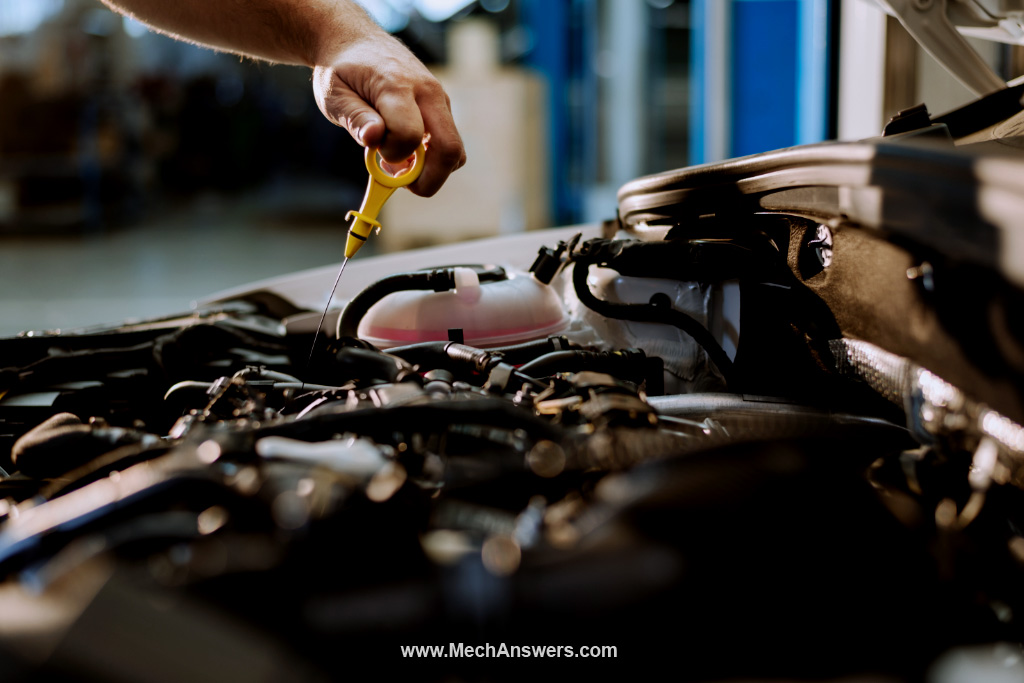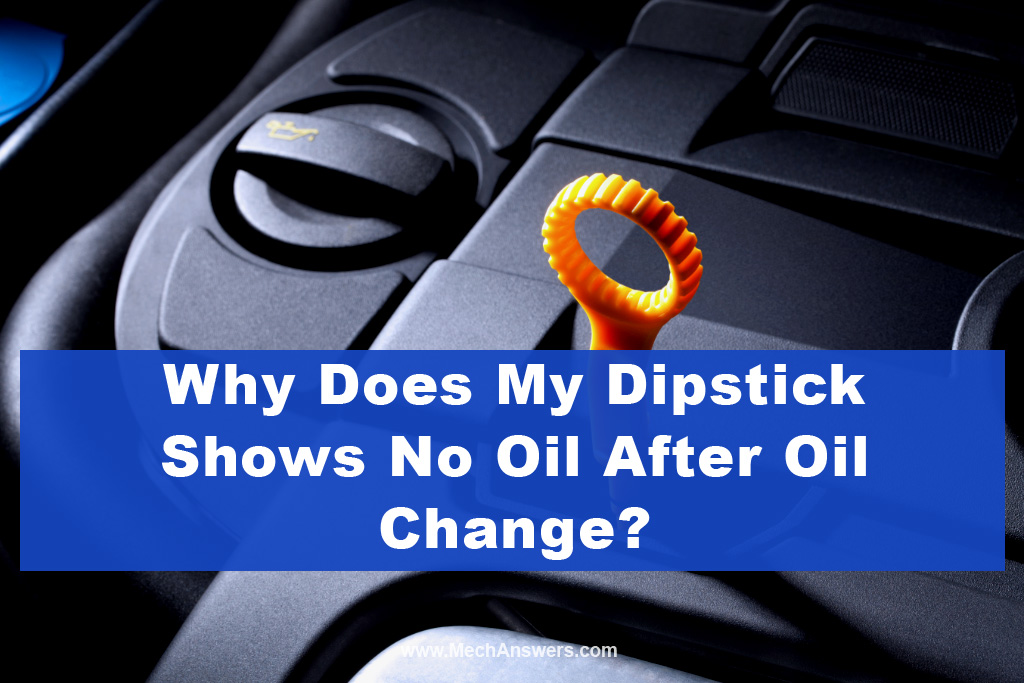Did you recently change your car’s oil and now you’re wondering, “Why Does My Dipstick Show No Oil After Oil Change?” If so, you’re not alone. Many car owners have typed this exact phrase into search engines, looking for answers. Well, your search ends here because we are going to shed light on this peculiar issue.
So, why does your dipstick show no oil even after an oil change? Possible reasons could be the engine consuming the oil, a leak, improper reading of the dipstick, or insufficient oil being added during the change.
In the following sections, we will explore each of these possibilities in detail to provide a comprehensive understanding of the issue at hand.
Table of Contents
What Is A Dipstick And Where I Can Find It?
A dipstick is a simple tool used to measure the level of fluids in a car’s engine. It is usually made of metal or plastic and is marked with various measurements in order to accurately measure the amount of oil inside the engine. Dipsticks are typically found in the engine bay, near the engine block.
To use the dipstick, simply pull it out of its holder and wipe any oil off the end. Next, insert it back into the engine and pull it out again.
Check the end of the dipstick to see how much oil is present in the engine. If the oil level is too low, it is recommended to top up the oil to the correct level. If the oil level is higher than the maximum level, it is important to drain some of the excess oil out.

How To Use A Dipstick To Check The Oil Level
A dipstick is an essential tool for checking the oil level in a car. It is a long, thin piece of metal that is inserted into the oil dipstick tube, located on the side of the engine. This tube allows for a quick and easy measurement of the oil level in the engine.
Before checking the oil level with a dipstick, it is important to ensure that the engine has been off for at least 15 minutes. This allows the oil to settle into the oil pan and for an accurate measurement.
Once the engine has been off for at least 15 minutes, open the hood and locate the dipstick. Carefully remove the dipstick and wipe it clean with a rag. Insert the dipstick back into the tube and push it all the way to the bottom.
Carefully remove the dipstick and examine the oil level. The oil should reach the full mark on the dipstick, which indicates that the oil level is sufficient. If the oil does not reach the full mark, it is necessary to add more oil to the engine.

Why Does My Dipstick Show No Oil After An Oil Change?
Incorrect oil level:
If the proper amount of oil was not added during the oil change, the dipstick will still show no oil after the oil change.
Oil Filter:
If the oil filter was not replaced during the oil change, the dipstick will still show no oil after the oil change.
Plugged Oil Drain Plug:
If the oil drain plug is plugged, the oil will not be able to flow back into the engine, thus the dipstick will still show no oil after the oil change.
Low Oil Pressure:
If the oil pressure is low, the oil may not be able to reach the dipstick, thus the dipstick will still show no oil after the oil change.
Worn Out Oil Pump:
If the oil pump is worn out, it may not be able to pump oil up to the dipstick, thus the dipstick will still show no oil after the oil change.
Dirty Oil:
If the oil has become dirty, the dipstick may not be able to register the oil, thus the dipstick will still show no oil after the oil change.
Incorrect Oil Grade:
If the wrong oil grade was used during the oil change, the dipstick will still show no oil after the oil change.
Oil Leakage:
If the car is leaking oil, the dipstick will still show no oil after the oil change.
Cracked Engine Block:
If the engine block is cracked, the oil may be leaking out of the engine, thus the dipstick will still show no oil after the oil change.
Clogged Oil Pick-Up Tube:
If the oil pick-up tube is clogged, the oil may not be able to reach the dipstick, thus the dipstick will still show no oil after the oil change.
Faulty Dipstick:
If the dipstick is faulty, it may not be able to register the oil, thus the dipstick will still show no oil after the oil change.
Air Bubbles:
If there are air bubbles in the system, the dipstick may not be able to register the oil, thus it will still show no oil after the oil change.
Too much oil:
If too much oil was added during the oil change, the dipstick may not show any oil.
Leaking seals:
Oil may be leaking from the seals around the engine, resulting in the dipstick not showing any oil.

How Much Oil Should Be After An Oil Change?
Oil changes are an essential part of car maintenance. Performing oil changes regularly helps keep your car running smoothly and optimally. An oil change involves draining the old oil and replacing it with new oil.
The amount of oil that should be in your car after an oil change depends on the size of the engine and the type of oil you use. Generally, for a 4-cylinder engine, the amount of oil should be around 3.2 quarts. For a 6-cylinder engine, the amount should be around 4.5 quarts.
In addition to the type of engine, the type of oil you use also affects how much oil should be in the car. Conventional oil is typically cheaper but needs to be changed more frequently. Synthetic oil is more expensive but lasts longer and can be used in some engines for up to 15,000 miles.
It’s important to always check the owner’s manual for the recommended oil change intervals and the amount of oil needed for your specific car. It’s also important to make sure you’re using the correct type of oil for your vehicle.
Following these guidelines will help ensure your car is running optimally and that the correct amount of oil is in the engine after an oil change.
What Should You Do If There Is No Oil On A Dipstick After An Oil Change?
- If there is no oil on the dipstick after an oil change, the first thing you should do is check the oil level in the engine. If the oil level is low, the oil may have not been filled to the proper level. You should add oil to the engine until it is at the full level indicated on the dipstick.
- You should also check the oil filter to make sure it was replaced correctly. If the oil filter was not installed correctly, it can cause the oil to not be present on the dipstick.
- If the oil filter is fine, you should check the oil pan to make sure it is not leaking. If the oil pan is leaking, it will cause the oil to not be present on the dipstick.
- If the oil pan is not leaking, you should check the oil pump to make sure it is functioning properly. If the oil pump is not working properly, it can cause the oil to not be present on the dipstick.
- If the oil pump is fine, you should check the oil drain plug to make sure it is not leaking. If the oil drain plug is leaking, it will cause the oil to not be present on the dipstick.
- If the oil drain plug is fine, you should check the oil pressure sensor to make sure it is functioning properly. If the oil pressure sensor is not working properly, it can cause the oil to not be present on the dipstick.
- If the oil pressure sensor is fine, you should check the oil filter mounting hardware to make sure it is secure and not leaking. If the hardware is loose or leaking, it can cause the oil to not be present on the dipstick.
- If the oil filter mounting hardware is secure, you should check the oil pan gasket to make sure it is not leaking. If the oil pan gasket is leaking, it will cause the oil to not be present on the dipstick.
- If the oil pan gasket is fine, you should check the engine for any other possible oil leaks. If there are any other oil leaks, they can cause the oil to not be present on the dipstick.
- If there are no other oil leaks, you should check the oil filter for clogs. If the oil filter is clogged, it can cause the oil to not be present on the dipstick.
- If the oil filter is fine, you should check the oil pump for any blockages. If the oil pump is blocked, it can cause the oil to not be present on the dipstick.
- If all of the above checks have been done and the oil is still not present on the dipstick, you should contact a mechanic to inspect and repair the problem
WARNING. No Oil On The Dipstick Means No Oil In The Motor. Let’s talk >> Check out the video below:
Related Articles
Read more >> No Leak, No Overheating: 12 Causes of Losing Coolant
Read more >> Can The Wrong Oil Cause Overheating? Simply Explained!
Read more >> How Much & When Is It Normal For The Coolant Level To Drop?
Read more >> Why Does My Dipstick Shows No Oil After Oil Change? (Facts!)
Read more >> How Much is Walmart Full Synthetic Oil Change? (Facts)
Read more >> What To Do If Engine Oil is Low? 15 Symptoms and Solutions!
Conclusion
Oil not showing up on the dipstick after an oil change could be caused by a number of factors. The most common reasons for this are the oil not being filled to the correct level, or the dipstick not being inserted properly.
It is also possible that the oil filter was not replaced correctly, or that the oil was not of the correct viscosity. If these issues are not addressed, it can lead to costly repairs or even engine failure.
It is important to take the time to ensure that the oil level is correct and the dipstick is inserted properly after an oil change.
If you are unsure how to properly fill the engine oil and correctly insert the dipstick, it is best to consult a qualified mechanic. In order to prevent any future issues, it is important to check the oil level regularly and perform regular oil changes. Doing so will help to ensure that your engine is running at its best.

